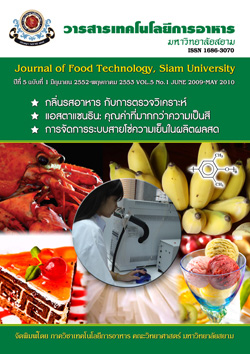คุณลักษณะของเอนไซม์พอลิฟีนอลออกซิเดสในกล้วยน้ำว้า Musa sapientum Linn.
Main Article Content
Abstract
เอนไซม์พอลิฟีนอลออกซิเดส (Polyphenol Oxidase: PPO) ในเน้ือกล้วยน้ำว้า [Musa sapientum Linn. (ABB group)] เป็นสาเหตุที่ทำให้เกิดสีที่ไม่เป็นที่ต้องการในผลิตภัณฑ์จากเนื้อกล้วยน้ำว้า ดังน้ันงานวิจัยน้ีมีวัตถุประสงค์เพื่อศึกษาผลของความเป็นกรด-ด่าง (pH) อุณหภูมิ กรดซิตริก และกรดแอสคอร์บิก ต่อคุณลักษณะ และกิจกรรมของเอนไซม์พอลิฟีนอลออกซิเดสในกล้วยน้ำว้า จากผลการทดสอบทางประสาทสัมผัส พบว่าเน้ือกล้วยน้ำว้า สุกระยะท่ี 7 ได้รับคะแนนทางประสาทสัมผัสสูงท่ีสุดอย่างมี นัยสำคัญทางสถิติ (p<0.05) ดังน้ันจึงเลือกใช้เนื้อกล้วยน้ำว้า สุกระยะท่ี 7 ในการศึกษาครั้งน้ี ผลการทดลองพบว่า เอนไซม์พอลิฟีนอลออกซิเดสท่ีสกัดได้ มีค่าความเป็นกรด- ด่างท่ีเหมาะสมกับการทำงานเท่ากับ 5.0 ที่อุณหภูมิ 25 °C และสูญเสียกิจกรรม ไป 65.82 % และ 88.77 % เมื่อบ่มที่ pH 3.0 และ pH 9.0 นาน 10 นาที ตามลำดับ มีอุณหภูมิที่เหมาะสมกับการทำงานเท่ากับ 30 °C เมื่อตรวจวัด เสถียรภาพของเอนไซม์พอลิฟีนอลออกซิเดสที่สกัดได้ที่ค่า pH ต่างๆ พบว่าเมื่อบ่มในสารละลายบัฟเฟอร์ท่ีช่วง pH 4.0- 9.0 อุณหภูมิ 0 °C เป็นเวลา 30 นาที เอนไซม์จะมีกิจกรรม เหลืออยู่ 70 % เมื่อตรวจวัดสเถียรภาพของเอนไซม์พอลิฟีนอลออกซิเดสท่ีสกัดได้ต่ออุณหภูมิต่างๆ พบว่า เมื่อบ่มใน สารละลายบัฟเฟอร์ pH 7 ท่ีอุณหภูมิช่วง 0-60 °C เป็นเวลา 10 นาที เอนไซม์ยังคงรักษากิจกรรมไว้ได้ และสามารถ ยับยั้งกิจกรรมของเอนไซม์ได้จากได้อย่างสมบูรณ์ เมื่อบ่มที่ อุณหภูมิ 80 °C นาน 10 นาที นอกจากน้ีการใช้กรดซิตริก หรือกรดแอสคอร์บิก ความเข้มข้นในช่วง 0.5-1.5 % โดย นำ้หนัก/ปริมาตร สามารถยับยั้งกิจกรรมของเอนไซม์พอลิฟีนอลออกซิเดสที่สกัดจากเน้ือกล้วยน้ำว้าได้อย่างสมบูรณ์
Characterization of Polyphenol Oxidase (PPO) in Banana (Musa sapientum Linn.)
Banana [Musa sapientum Linn. (ABB group) ‘Kluai Nam Wa’] polyphenol oxidase (PPO) causes undesirable color in banana products. The aim of this research was to investigate the effect of pH and temperature on the characterization of banana PPO including citric acid and ascorbic acid effects on the PPO activity. The sensory evaluation results showed that the ‘Kluai Nam Wa’ flesh in the stage 7 (PCI 7) had the most acceptability (p<0.05); the PCI 7 of this banana was chosen for this study. The optimum pH of crude PPO was 5.0 at 25 °C and 65.82% and 88.77% loss of activity was found after incubation at pH 3.0 and pH 9.0 for 10 min. The enzyme had maximum activity at temperature (optimum temperature) 30°C. The results from pH stability studies showed that 70 % of crude PPO activity was maintained after incubation for 30 min at 0°C in a buffer solution at pH 4.0 – 9.0. From the temperature stability studies, the enzyme had relatively stable when incubated at 0-60oc for 10 minutes in the buffer solution at pH 7.0. The enzyme activity was completely inactivated when it exposed to 80 oC for 10 minutes. Moreover, 0.5- 1.5% (w/v) citric acid and ascorbic acid fully inhibited the PPO activity.
Article Details
Copyrights of all articles in the Journal of Food Technology available in print or online are owned by Siam University and protected by law.


